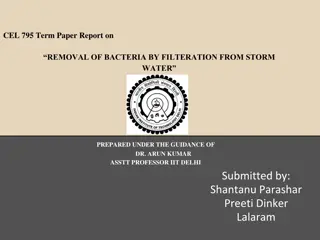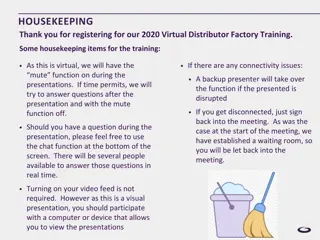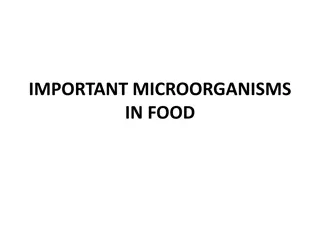Enhancing Bacteria Removal from Storm Water through Advanced Filtration Methods
In this term paper report, the focus is on maximizing the removal of bacteria, including pathogens like E. coli, from stormwater using sand media filters. The study reviews current research on sand media filters, compares different filter types, analyzes parameters affecting filter performance, and suggests potential improvements such as pre-filtration screening and post-filtration treatments like chlorination or UV disinfection.
Download Presentation

Please find below an Image/Link to download the presentation.
The content on the website is provided AS IS for your information and personal use only. It may not be sold, licensed, or shared on other websites without obtaining consent from the author.If you encounter any issues during the download, it is possible that the publisher has removed the file from their server.
You are allowed to download the files provided on this website for personal or commercial use, subject to the condition that they are used lawfully. All files are the property of their respective owners.
The content on the website is provided AS IS for your information and personal use only. It may not be sold, licensed, or shared on other websites without obtaining consent from the author.
E N D
Presentation Transcript
CEL 795 Term Paper Report on REMOVAL OF BACTERIA BY FILTERATION FROM STORM WATER PREPARED UNDER THE GUIDANCE OF DR. ARUN KUMAR ASSTT PROFESSOR IIT DELHI Submitted by: Shantanu Parashar Preeti Dinker Lalaram
Background and objective Parameter of concern in rain water : Total solids : Dissolved salts, metals, suspended solids Pathogens: E. coli, Cryptosporidium, Giardia, Campylobacter, Vibrio, Salmonella and Pseudomonas Background: inadequate microbial removal capacity of conventional sand media Objective : To Review all present research going on sand media filter for maximization of removal of bacteria from rain water
Method used 1. Understanding of the hydraulic flow condition within the filter and comparison with SSF Uniform drip flow over the sand surface by use of a plastic or sheet metal diffuser Depth of the BSF sand layer is about 50% less than for the SSF (0.4 m compared to a recommended starting depth of >0.8 m for the SSF with a minimum of 0.5 0.7 m) Maximum recommended filtration rate of the BSF is nearly 15 times greater than for the SSF (1.1 m/h in contrast to a recommended ( 0.08 0.4m/h) (Fox et al., 1994) BSF uses local material whereas SSF sand are mostly from a commercial source. 2. Key parameters of filter operation and their effects on filter performance Enhanced particle straining due to bio layer formation Improved depth filtration by slowing the filtration rate Altered the surface properties of the filtration media. 3. Examine and compare e-coli removal from (bio sand filter-standard (BSF-S), biosand iron coated.(MBSF) 4. different microorganisms (MS-2, E. coli and poliovirus) was passed through columns containing sand modified by FeCl3 and AlCl3
Observation Present status Removal of turbidity by the BSF was not as high as reported for conventional SSF (Sims and Slezak, 1991) MBSF showed a slightly higher effluent turbidity compared to BSF (Mansoor M.A, Davra K,2011) Amount of water per charge and pause period are important operating parameters for both BSF and MBSF (Baumgartner et al ,2007) (Elliott et al,2008) Microbial reductions could be increased by increasing the retention time of water in the filter(Elliott et al,2008) MBSF always gave better performance in terms of bacteria removal in comparison to BSF (Mansoor M.A, Davra K,2011) Ripening and biofilm development defy easy quantification based on water volume and water quality charged to the filter per day (Campos et al., 2002)
Possibility of improvement To improve removal efficiency Screening can be used before filtration to remove suspended solid. Chlorination can be performed after filtration UV rays or solar disinfection can further improve the process.
Challenges and future scope Mechanisms of virus removal or inactivation in the BSF, however, require further investigation Biofilm development defy easy quantification based on water volume and water quality charged to the filter per day Organic matter and suspended solids interfere with the adsorption of virus in filter media .The performance of biosand filter under this situation requires investigation
Reference (1) Ahammed M. M., Davra K., Performance evaluation of biosand filter modified with iron oxide-coated sand for household treatment of drinking water, J. desalination 276(2011) 287-293 (2) American Public Health Association, Standards Methods for the Examination of Water and Wastewater, 20th ed. American Public Health Association/American Water Works Association/Water Pollution Control Federation, Washington DC, USA, 1998. (3) Cromeans T., Sobsey M. D., Fields H. A., 1987, Development of a plaque assay for a cytopathic, rapidly replicating isolate of hepatitis A virus, J. Med. Virol. 22, 45 56. (4) Elliott E. A., Stauber C. E., Koksal F., DiGiano F. A., M.D. Sobsey, Reductions of E. coli, echovirus type 12 and bacteriophages in an intermittently operated household-scale slow sand filter, J. Water research 42 (2008) 2662-2670 (5) Fox K.R., Graham N.J.D., Collins M.R., 1994, Slow sand filtration today: an introductory review. In: Collins, M.R., Graham, N.J.D. (Eds.), Slow Sand Filtration. American Water Works Association, Denver, CO, pp. 1 8. (6) Lukasik J., Cheng Y. F., Lu F., Tamplin M. and Farrah S. R., Removal of microorganism from water by columns containing sand coated with ferric and aluminum hydroxide, J. Wat. Res. Vol. 33, No. 3, pp. 769-777, 1999. (7) Sims R., Slezak L., 1991, Slow sand filtration: present practice in the United States. In: Logsdon, G. (Ed.), Slow Sand Filtration. American Society of Civil Engineers, New York, NY, pp. 1 18. (8) Sobsey M. D. and Jones B. L. (1979) Concentration of poliovirus from tap water using positively charged microporous filters. Appl. Environ. Microbiol. 3, 588 595. (9) Sobsey M. D., Cromeans T., Hickey A. R. and Glass J. S. (1984) Effects of water quality on microporous filter methods for enteric virus concentration. Water Sci. Technol. 17, 665 679.
(10) US Environmental Protection Agency, 2001. Method 1602: malespecific (F+) and somatic coliphage in water by single agar layer (SAL) procedure, Washington, DC, EPA 821-R-01-029. (11) US Environmental Protection Agency, 2002. Method 1604: total coliforms and Escherichia coli in water by membrane filtration using a simultaneous detection technique (MI Medium), Washington, DC, EPA 821-R-02-024 (12) World Health Organization (WHO), 2004, Water sanitation and hygiene links to health-facts and figures. (13) Stauber C.E., Elliott E.A., Koksal F., Ortiz G.M., DiGiano F.A., Sobsey M.D., Characterization of the biosand filter for E. coli reductions from household drinking water under controlled laboratory and field use conditions, Water Sci. Technol. 54 (2006) 1 7. (14) US Environmental Protection Agency, 2001. Method 1602: malespecific (F+) and somatic coliphage in water by single agar layer (SAL) procedure, Washington, DC, EPA 821-R-01-029. (15) US Environmental Protection Agency, 2002. Method 1604: total coliforms and Escherichia coli in water by membrane filtration using a simultaneous detection technique (MI Medium), Washington, DC, EPA 821-R-02-024 (16) World Health Organization (WHO), 2004, Water sanitation and hygiene links to health-facts (17) Haarhoff, J., Cleasby, J.L., 1991. Biological and physical mechanisms in slow sand filtration. In: logsdon, G. (Ed.), Slow Sand Filtration. American Society of Civil Engineers, New York. (18) Hijnen, W.A., Schijven, J.F., Bonne, P., Visser, A., Medema, G.J., 2004. Elimination of viruses, bacteria and protozoan oocysts by slow sand filtration. Water Sci. Technol. 50 (1), 1542 1552. (19 Sagripanti, J.L., Routson, L.B., Lytle, C.D., 1993. Virus inactivation by copper or iron ions alone and in the presence of peroxide. Applied and Environmental Microbiology 59, 4374e4376 (20) Weber-Shirk, M.L., Dick, R.D., 1997. Biological mechanisms in slow sand filters. Journal of American Water Works Association 89 (2), 72e83.























